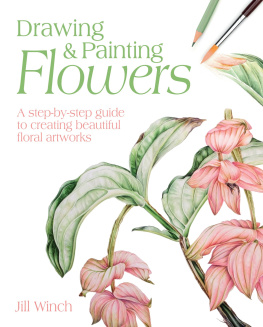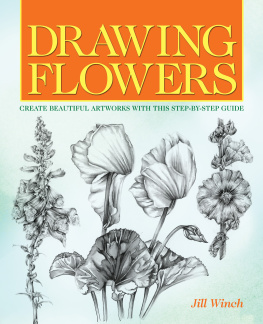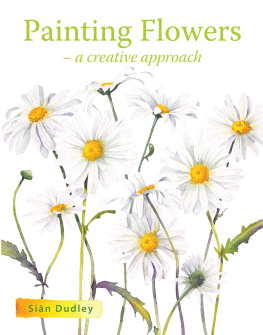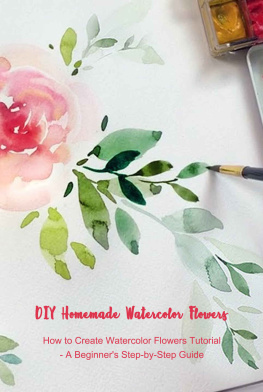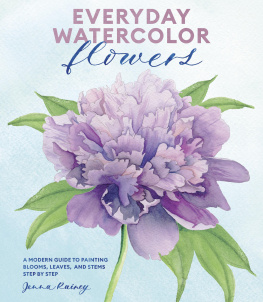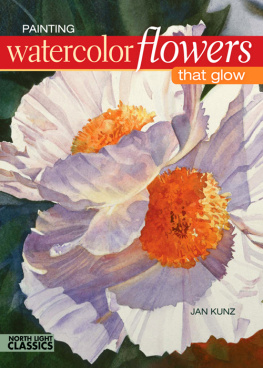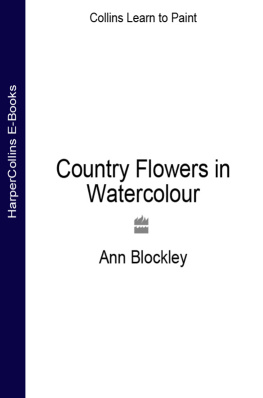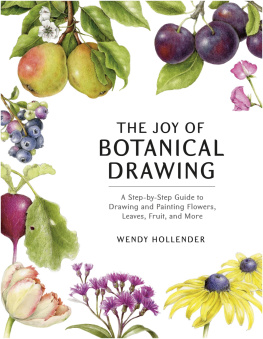
INTRODUCTION
This book is designed to help you get started on drawing, and then painting floral subjects and allowing you to develop your skills. A love of flowers is a good starting point but practice is key to achieving success, and although it might be tempting to skip the exercises at the beginning of each section and get on with an exciting floral portrait they should not be ignored as they will start you on the right road to lots of enjoyment and artistic satisfaction.

This book is a wonderful opportunity for me to pass on the knowledge and experience that I have gained, not only through years of drawing but also from teachingknowing what is required to give someone the confidence to put pencil or brush to paper and take them through the fundamentals of drawing or painting. The book is designed for everyone, from the beginner to the more experienced.
Drawing is not a mystery known only to some but elusive to others. Through continual practice and breaking down the process into small elements that make up the whole, you will find success.
Watercolor is the most popular medium for painting flowers, and although it can be considered challenging you will find that you can achieve success by using the correct tools and techniques. The best way to tackle it is to start with exercises that are easily achievable. My students get stressed about ruining a piece of paper they are working on, but there may be many pieces of discarded paper along your road to success; with each piece more lessons will have been learned about what you do and dont do.
Finding a regular class to join and keeping an eye out for more specialized workshops can be helpful in the understanding of this huge subject. The Internet can be an excellent source of information and on a smaller scale a local art shop can often advise on nearby art societies that hold painting sessions. Art groups often invite artists to give talks and demonstrations from which there is much to be learned and joining a group brings many other benefits, such as meeting like-minded people and making friends as well as picking up tips on painting. I am still in contact with people I met in a painting group I attended many years ago and I know that the friendships made within the classes I hold now are invaluable to those attending.
However, if you join a group, take care not to constantly compare your work with that of other members. In many instances the only person holding us back is ourselves and our own lack of confidence; someone in the group who seems much more skilled than you could ever be has probably just had a lot more practice.
As you become more ambitious, finding a teacher with whom you have a good rapport is important. Having been very lucky with my teacher when I was first studying botanical art, I know how important it is to have someone who encourages you and is also able to show you how to paint; someone who is not only an excellent artist but also an excellent teacher (thank you, Isabel).
Exhibitions are an excellent form of education, as looking at how botanical artists have used their chosen medium will help you form your own ideas of how you would like to use your watercolor or pencils to achieve the results you admire. In time, you may find the confidence to enter your own work into an exhibition.
Looking through books of botanical art is a lovely way to find out how other artists have applied their paint and arranged their compositions. I feel you cannot have too many books and I treasure all of mine for when I can find some quiet time to immerse myself in the wonderful world of drawing and painting flowers.
Jill Winch

Materials and Equipment


Over the next few pages we shall look at the materials and equipment you will need for drawing and painting flowers. These include pencils for drawings, along with brushes, colored pencils, paints and papers. The range of art materials available in shops and online is wide and can be rather bewildering to a novice artist, so it is useful to understand what you want for your particular purposes before you start shopping and perhaps waste your money buying unsuitable items. Buying the best quality materials is ideal, but if you are on a budget there are ways to spend your money wisely rather than wasting it on poor-quality materials. We shall also discuss the equipment involved in drawing and painting flowers in particular, including vessels for holding them.

Pencils and accessories
While brands differ slightly in the range they offer, pencils are graded from 9H through to 9B, 9H being the hardest and 9B the softest, with HB and F in between. The H pencils can produce lovely light tones; for the darker shadow areas, I often use the softer B grades. The addition of small, intense areas of dark shading, made with a B pencil sharpened to a fine point with an emery board, can create instant drama in your drawing. Derwent, Faber-Castell and Staedtler are excellent manufacturers and you can buy a box with a good range of hard and soft leads. You can give the pencil lead an angled edge by using an emery board, which will enable you to produce both tone and very fine line.

Clutch pencils are versatile and useful as you can expose the lead to the required length and grind it to a fine point, again with an emery board. These pencils sometimes have a removable sharpener at the end. Use this with caution, as the fine graphite dust can sometimes remain in the sharpener and spill out on to your paper. The leads are quite thick usually 25mm. When you want a harder or a softer lead, change it by inserting it into the clutch mechanism at the tip.



A propelling pencil differs from a clutch pencil in that the leads used are usually finer at 0.3mm, 0.5mm and 0.7mm, and you simply push the end of the casing to propel the lead forward. These pencils can be used for fine, detailed work, but the lead is susceptible to snapping if you exert much pressure. Theres no need to sharpen it, as movement on the paper will produce the smooth edge that is required.

